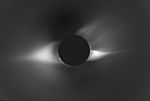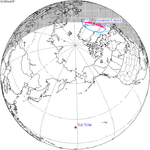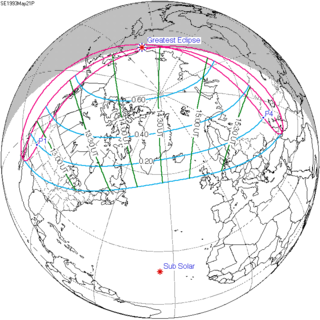Solar eclipse of May 21, 1993
| Solar eclipse of May 21, 1993 | |
|---|---|
| Type of eclipse | |
| Nature | Partial |
| Gamma | 1.1372 |
| Magnitude | 0.7352 |
| Maximum eclipse | |
| Coordinates | 68°48′N 162°18′E / 68.8°N 162.3°E |
| Times (UTC) | |
| Greatest eclipse | 14:20:15 |
| References | |
| Saros | 118 (67 of 72) |
| Catalog # (SE5000) | 9493 |
A partial solar eclipse occurred on May 21, 1993. A solar eclipse occurs when the Moon passes between Earth and the Sun, thereby totally or partly obscuring the image of the Sun for a viewer on Earth. A partial solar eclipse occurs in the polar regions of the Earth when the center of the Moon's shadow misses the Earth.
Images[edit]
Related eclipses[edit]
Eclipses of 1993[edit]
- A partial solar eclipse (north) on May 21.
- A total lunar eclipse (central, passing north of the axis) on June 4.
- A partial solar eclipse (south) on November 13.
- A total lunar eclipse (south) on November 29.
Solar eclipses 1993–1996[edit]
This eclipse is a member of a semester series. An eclipse in a semester series of solar eclipses repeats approximately every 177 days and 4 hours (a semester) at alternating nodes of the Moon's orbit.[1]
| Solar eclipse series sets from 1993 to 1996 | ||||||
|---|---|---|---|---|---|---|
| Descending node | Ascending node | |||||
| Saros | Map | Gamma | Saros | Map | Gamma | |
| 118 | 1993 May 21 Partial |
1.13720 | 123 | 1993 November 13 Partial |
−1.04114 | |
128 Partial from Bismarck, ND |
1994 May 10 Annular |
0.40771 | 133 Totality at Bolivia |
1994 November 3 Total |
−0.35216 | |
| 138 | 1995 April 29 Annular |
−0.33821 | 143 Totality at Dundlod, India |
1995 October 24 Total |
0.35176 | |
| 148 | 1996 April 17 Partial |
−1.05796 | 153 | 1996 October 12 Partial |
1.12265 | |
Saros 118[edit]
It is a part of Saros cycle 118, repeating every 18 years, 11 days, containing 72 events. The series started with partial solar eclipse on May 24, 803 AD. It contains total eclipses from August 19, 947 AD through October 25, 1650, hybrid eclipses on November 4, 1668 and November 15, 1686, and annular eclipses from November 27, 1704 through April 30, 1957. The series ends at member 72 as a partial eclipse on July 15, 2083. The longest duration of total was 6 minutes, 59 seconds on May 16, 1398.
| Series members 62–72 occur between 1901 and 2083: | ||
|---|---|---|
| 62 | 63 | 64 |
 Mar 29, 1903 |
 Apr 8, 1921 |
 Apr 19, 1939 |
| 65 | 66 | 67 |
 Apr 30, 1957 |
 May 11, 1975 |
 May 21, 1993 |
| 68 | 69 | 70 |
 Jun 1, 2011 |
 Jun 12, 2029 |
 Jun 23, 2047 |
| 71 | 72 | |
 Jul 3, 2065 |
 Jul 15, 2083 | |
Metonic series[edit]
The metonic series repeats eclipses every 19 years (6939.69 days), lasting about 5 cycles. Eclipses occur in nearly the same calendar date. In addition, the octon subseries repeats 1/5 of that or every 3.8 years (1387.94 days). All eclipses in this table occur at the Moon's descending node.[2]
| Octon series with 21 events between May 21, 1993 and August 2, 2065 | ||||
|---|---|---|---|---|
| May 20–21 | March 8–9 | December 25–26 | October 13–14 | August 1–2 |
| 98 | 100 | 102 | 104 | 106 |
| May 21, 1955 | March 9, 1959 | December 26, 1962 | October 14, 1966 | August 2, 1970 |
| 108 | 110 | 112 | 114 | 116 |
| May 21, 1974 | March 9, 1978 | December 26, 1981 | October 14, 1985 | August 1, 1989 |
| 118 | 120 | 122 | 124 | 126 |
 May 21, 1993 |
 March 9, 1997 |
 December 25, 2000 |
 October 14, 2004 |
 August 1, 2008 |
| 128 | 130 | 132 | 134 | 136 |
 May 20, 2012 |
 March 9, 2016 |
 December 26, 2019 |
 October 14, 2023 |
 August 2, 2027 |
| 138 | 140 | 142 | 144 | 146 |
 May 21, 2031 |
 March 9, 2035 |
 December 26, 2038 |
 October 14, 2042 |
 August 2, 2046 |
| 148 | 150 | 152 | 154 | 156 |
 May 20, 2050 |
 March 9, 2054 |
 December 26, 2057 |
 October 13, 2061 |
 August 2, 2065 |
| 158 | 160 | 162 | 164 | 166 |
 May 20, 2069 |
March 8, 2073 | December 26, 2076 | October 13, 2080 | August 1, 2084 |
References[edit]
- ^ van Gent, R.H. "Solar- and Lunar-Eclipse Predictions from Antiquity to the Present". A Catalogue of Eclipse Cycles. Utrecht University. Retrieved 6 October 2018.
- ^ Note S1: Eclipses & Predictions in Freeth, Tony (2014). "Eclipse Prediction on the Ancient Greek Astronomical Calculating Machine Known as the Antikythera Mechanism". PLOS ONE. 9 (7): e103275. Bibcode:2014PLoSO...9j3275F. doi:10.1371/journal.pone.0103275. PMC 4116162. PMID 25075747.
External links[edit]
- NASA graphics
- Photo of eclipse from Novocheboksarsk, Chuvashia (in Russian). Metadata of photo





